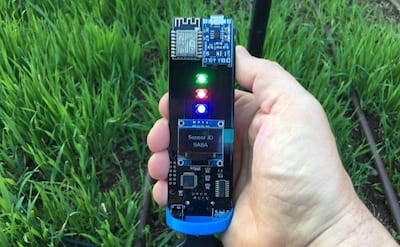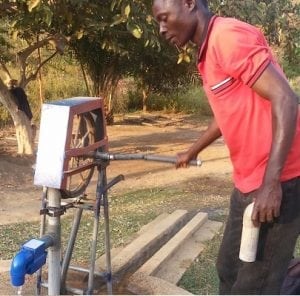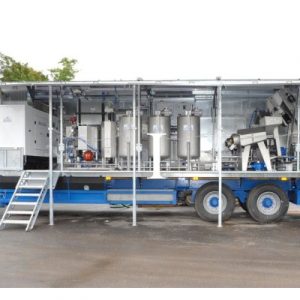
Agriculture
February 7, 2024
Soilsense Soil Sensor
Read SolutionImplemented by
SoilSense

Updated on February 6, 2024
·Created on May 24, 2016
Chameleon Soil Moisture Sensor is an instrument which measures water level and moisture content of soil to help farmers to know when to irrigate.
The Chameleon Soil Moisture Sensor is a prototype sensor designed to increase water management techniques for smallholder irrigators on their farms. Applications of the Chameleon sensor include providing information on when to irrigate to avoid water stress, how to avoid water-logging, determining when the soil profile is susceptible to fertilizer leaching, and improving the usefulness of rainfall. This sensor can also help farmers determine where the roots are actively taking up water giving farmers insight on when to irrigate and how much water to apply. The kit includes a field reader, sensor array, connector, and battery charging cable.
Target SDGs
SDG 2: Zero Hunger
SDG 9: Industry, Innovation and Infrastructure
Market Suggested Retail Price
$210.00
Target Users (Target Impact Group)
Household, Community
Distributors / Implementing Organizations
CSIRO oversees distribution of the product.
Regions
Africa
Countries
Mozambique, Tanzania, Zimbabwe
Manufacturing/Building Method
The sensor was developed in a project funded by the Australian Centre for International Agricultural Research. It is made of resistivity sensor and colour diodes, connected to a mobile phone app.
Intellectural Property Type
Trade Secret
User Provision Model
Users can purchase the sensor for through CSIRO's Virtual Irrigation Academy Shop
Distributions to Date Status
As of July 2016, there are approximately 2000 sensors in the ground being used by farmers in Africa Interview with representative
Accuracy range
Unknown
Parameters tested
Soil moisture
Power source
Solar
Sensor
Resistivity sensor
Design Specifications
The resistivity sensor is buried in the soil and a reader which transmits data to colour diodes is connected to the sensor. The sensor measures tension in the soil at three different depths and gives a colour-coded output i.e. blue means the soil is wet (0 to 20 kPa): do not irrigate, green means the soil is moist (20 to 50 kPa): get ready to irrigate and red means the soil is dry (greater than 50kPa): irrigate. The output can also be displayed on a card, which displays a one colour output.
Technical Support
The Commonwealth Scientific and Industrial Research Organisation (CSIRO) provides technical support for users.
Replacement Components
Replacement sensors and field readers are available through the Virtual Irrigation Academy Shop.
Lifecycle
The longevity of gypsum based sensors is listed as a possible concern and further testing will reveal the lifespan of the sensors. Current sensors have been in the ground for over 3 years and are still performing properly Interview with representative
Manufacturer Specified Performance Parameters
The sensor is designed to help small-scale farmers to properly irrigate their farms
Vetted Performance Status
As part of the project funded by the Australian Centre for International Agricultural Research, the sensor was tested and found to be effective in helping farmers improve their irrigation practices.
Safety
When facilitating repairs to the sensor, basic electrical precautions should be taken.
Complementary Technical Systems
A mobile app was designed by CSIRO to relay information from the sensor.
Academic Research and References
Moyo, M., Van Rooyen, A., Bjornlund, H., Parry, K., Stirzaker, R., Dube, T., and Maya, M., 2020, The dynamics between irrigation frequency and soil nutrient management: transitioning smallholder irrigation towards more profitable and sustainable systems in Zimbabwe. International Journal of Water Resources Development, pp 1-25.
Svedberg, E., 2019, Impact on yield and water productivity of wheat by access to irrigation scheduling technologies in Koga Irrigation Scheme, Ethiopia. Master of science thesis, Swedish University of Agricultural Sciences, Uppsala, Sweden.
Stirzaker, R., Mbakwe, I., and Mziray, N. R., 2017, A soil water and solute learning system for small-scale irrigators in Africa. International Journal of Water Resources Development, 33(5), pp 788-803.
Compliance with regulations
Unknown
Other Information

Agriculture
February 7, 2024
Implemented by
SoilSense

Agriculture
June 24, 2024
Implemented by
Charity: water

Agriculture
June 24, 2024
Implemented by
WellDone

Agriculture
March 1, 2024

Agriculture
March 4, 2024
Implemented by
Makiga Engineering Services LTD

Agriculture
August 29, 2024
Implemented by
Alvan Blanch

Agriculture
June 22, 2024
Implemented by
Bespoke Design Concepts

Agriculture
January 10, 2024
Implemented by
Shaktiman
Agriculture
February 6, 2024
Implemented by
SAYeTECH Ltd

Agriculture
September 18, 2024
Implemented by
Alvan Blanch
Have thoughts on how we can improve?
Give Us Feedback
Where are you trialling these in Tanzania please? would it be possible to get involved in a pilot?